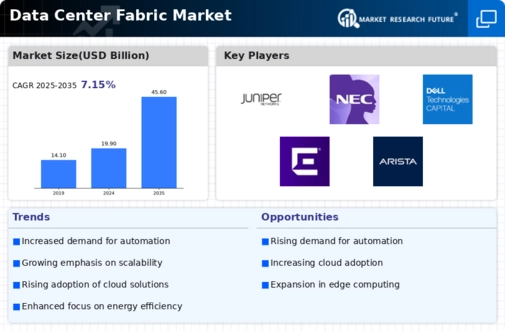Market Growth Projections
The Global Data Center Fabric Market Industry is projected to experience substantial growth in the coming years. By 2035, the market is expected to reach 45.6 USD Billion, reflecting a compound annual growth rate (CAGR) of 7.84% from 2025 to 2035. This growth is driven by various factors, including the increasing demand for cloud services, the rise of IoT, and advancements in networking technologies. The market dynamics suggest a robust trajectory, with organizations increasingly recognizing the strategic importance of data center fabrics in supporting their digital transformation initiatives.
Rising Demand for Cloud Services
The Global Data Center Fabric Market Industry is experiencing a surge in demand for cloud services, driven by businesses transitioning to cloud-based infrastructures. This shift is largely attributed to the need for scalability, flexibility, and cost efficiency. As organizations increasingly adopt hybrid and multi-cloud strategies, the data center fabric becomes crucial in ensuring seamless connectivity and management of resources. In 2024, the market is projected to reach 19.9 USD Billion, reflecting the growing reliance on cloud solutions. This trend is expected to continue, with the market potentially expanding as more enterprises recognize the benefits of cloud integration.
Increased Data Traffic and IoT Growth
The proliferation of Internet of Things (IoT) devices is significantly impacting the Global Data Center Fabric Market Industry. With billions of devices connected globally, data traffic is escalating at an unprecedented rate. This surge necessitates robust data center infrastructures capable of handling vast amounts of data efficiently. As organizations invest in advanced data center fabrics to accommodate this growth, the market is likely to witness substantial expansion. The anticipated growth in data traffic, coupled with the increasing complexity of data management, positions the data center fabric as a vital component in modern data architectures.
Advancements in Networking Technologies
Technological advancements in networking are reshaping the Global Data Center Fabric Market Industry. Innovations such as software-defined networking (SDN) and network function virtualization (NFV) are enabling more agile and efficient data center operations. These technologies facilitate better resource allocation, improved performance, and enhanced security. As organizations adopt these cutting-edge solutions, the demand for sophisticated data center fabrics is expected to rise. The integration of advanced networking technologies not only streamlines operations but also supports the growing complexity of data environments, positioning the market for continued growth.
Regulatory Compliance and Data Security
The Global Data Center Fabric Market Industry is significantly affected by the increasing focus on regulatory compliance and data security. As data breaches and cyber threats become more prevalent, organizations are compelled to invest in robust data center infrastructures that ensure compliance with regulations such as GDPR and HIPAA. Data center fabrics play a critical role in enhancing security measures and enabling organizations to protect sensitive information. This heightened awareness of data security is likely to drive market growth, as businesses prioritize investments in secure and compliant data center solutions.
Focus on Energy Efficiency and Sustainability
The Global Data Center Fabric Market Industry is increasingly influenced by the emphasis on energy efficiency and sustainability. Organizations are under pressure to reduce their carbon footprints and operational costs, prompting investments in energy-efficient data center solutions. Data center fabrics that optimize power consumption and enhance cooling efficiency are becoming essential. This trend aligns with global sustainability goals, as companies seek to comply with regulations and meet consumer expectations for environmentally responsible practices. As a result, the market is expected to grow, with energy-efficient solutions likely driving innovation and investment in the coming years.
















